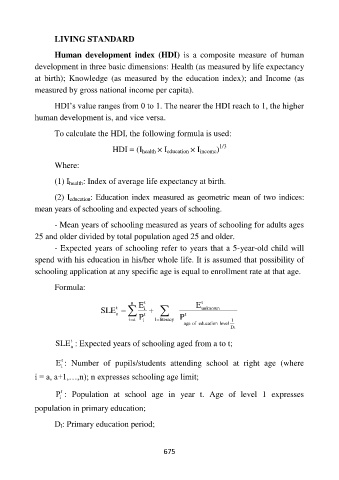Page 675 - index
P. 675
LIVING STANDARD
Human development index (HDI) is a composite measure of human
development in three basic dimensions: Health (as measured by life expectancy
at birth); Knowledge (as measured by the education index); and Income (as
measured by gross national income per capita).
HDI’s value ranges from 0 to 1. The nearer the HDI reach to 1, the higher
human development is, and vice versa.
To calculate the HDI, the following formula is used:
1/3
HDI = (I health × I education × I income)
Where:
(1) I health: Index of average life expectancy at birth.
(2) I education: Education index measured as geometric mean of two indices:
mean years of schooling and expected years of schooling.
- Mean years of schooling measured as years of schooling for adults ages
25 and older divided by total population aged 25 and older.
- Expected years of schooling refer to years that a 5-year-old child will
spend with his education in his/her whole life. It is assumed that possibility of
schooling application at any specific age is equal to enrollment rate at that age.
Formula:
SLE a t n E t i t t E t unknown
i a P i l literacy P l
age of education level
D l
t
SLE : Expected years of schooling aged from a to t;
a
t
E : Number of pupils/students attending school at right age (where
i
i a, a+1,…,n); n expresses schooling age limit;
t
P : Population at school age in year t. Age of level 1 expresses
i
population in primary education;
D l: Primary education period;
675

